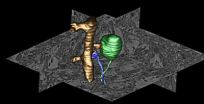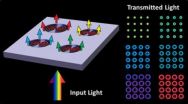(Press-News.org) WASHINGON, D.C.—February 7, 2013—Today, The Lancet Infectious Diseases published a new report that examines the global economic burden of Chagas disease. In the first study of its kind, researchers measured the health and economic impact of Chagas disease and found that the total economic burden of Chagas disease matches or exceeds that of many more well-known diseases such as rotavirus, Lyme disease and cervical cancer.
Chagas disease infects an estimated 10 million people worldwide, with most cases occurring in Latin America. It is a parasitic infection transmitted through an insect commonly known as the "kissing bug." Its symptoms range from acute respiratory and intestinal infections to strokes, liver and heart disease. In some cases Chagas disease can be fatal.
The poorest countries in the region are especially impacted by this neglected tropical disease (NTD) because of the insect's propensity to live in impoverished communities that lack quality housing, access to essential medicines and vector control practices. However the new study found that while the burden is considerable in Latin America, it is also significant in parts of the world not traditionally considered risk areas for Chagas disease, such as in North America and Europe.
The study estimates that the global economic cost of Chagas disease exceeds USD $7 billion annually. This cost surpasses that of rotavirus ($2 billion) and cervical cancer ($4.7 billion). Even in the United States, the economic burden of Chagas disease is comparable to the burden of much more publicized infectious diseases such as Lyme disease. According to the study, currently infected individuals will result in more future health care costs occurring in the United States (approximately $6.7 billion) than any other country.
"Lost productivity is a big part of the cost," said the study's lead author, Dr. Bruce Lee. "By just focusing on health care costs, or simple measures such as death caused by the disease, we miss a lot of the burden. We must examine the crucial impact lost productivity can have on society, businesses, governments and other key stakeholders."
Quantifying the economic burden of Chagas disease can help guide public health policy decisions, according to the study's co-author, Dr. Peter Hotez.
"We now have more evidence that Chagas disease is more than just a burden on human health in some of the poorest countries. All around the world, Chagas disease has a huge economic impact," said Dr. Hotez. "This new data should help inform policy decisions that will prioritize Chagas disease on research, policy and development agendas. This should include support for developing new vaccines for Chagas disease."
The Sabin Vaccine Institute Product Development Partnership (Sabin PDP), in collaboration with Texas Children's Hospital, Baylor College of Medicine and other PDP partners, is currently engaged in early research and development for a bivalent therapeutic vaccine for the treatment of chronic Chagas disease. If successful, it would be the first therapeutic vaccine for the treatment of this disease.
"Further studies quantifying Chagas disease-related costs on a regional or country level will help policymakers and other decision makers establish necessary control measures," added Dr. Hotez.
###
This paper was authored by Dr. Bruce Lee, associate professor of Medicine and Biomedical Informatics and director of the Public Health Computational and Operations Research (PHICOR) group, at the University of Pittsburgh and Dr. Peter Hotez, president of the Sabin Vaccine Institute, dean of the National School of Tropical Medicine at Baylor College of Medicine, director of the Sabin Vaccine Institute and Texas Children's Hospital Center for Vaccine Development and the fellow in Disease and Poverty at the James A. Baker III Institute for Public Policy at Rice University.
The study was funded by the Bill & Melinda Gates Foundation and the Models of Infectious Disease Agent Study (MIDAS) program of the National Institute of General Medical Sciences, National Institutes of Health (grant number 5U54GM088491-02).
The full paper is available on TheLancet.com and Sabin.org.
About Sabin Vaccine Institute
Sabin Vaccine Institute is a non-profit, 501(c)(3) organization of scientists, researchers, and advocates dedicated to reducing needless human suffering caused by vaccine preventable and neglected tropical diseases. Sabin works with governments, leading public and private organizations, and academic institutions to provide solutions for some of the world's most pervasive health challenges. Since its founding in 1993 in honor of the oral polio vaccine developer, Dr. Albert B. Sabin, the Institute has been at the forefront of efforts to control, treat and eliminate these diseases by developing new vaccines, advocating use of existing vaccines and promoting increased access to affordable medical treatments. For more information please visit www.sabin.org.
About The Sabin Vaccine Institute Product Development Partnership (Sabin PDP)
The Sabin PDP is focused on developing vaccines targeting neglected tropical diseases and the world's first and only vaccine initiative targeting human hookworm infection. This product development partnership (PDP) engages partners in academia, industry, government and civil society to fill an important market gap by collaborating with world class research and development institutions to create ultra low-cost vaccines for poor and underserved populations. PDP members include Texas Children's Hospital, Baylor College of Medicine, the George Washington University, the Oswaldo Cruz Foundation (FIOCRUZ) (Brazil), the London School of Hygiene and Tropical Medicine (UK), the James Cook University (Australia), Birmex (Mexico), Cinvestav (Mexico), and Autonomous University of Yucatan (Mexico).
About the University of Pittsburgh School of Medicine
As one of the nation's leading academic centers for biomedical research, the University of Pittsburgh School of Medicine integrates advanced technology with basic science across a broad range of disciplines in a continuous quest to harness the power of new knowledge and improve the human condition. Driven mainly by the School of Medicine and its affiliates, Pitt has ranked among the top 10 recipients of funding from the National Institutes of Health since 1998. In rankings recently released by the National Science Foundation, Pitt ranked fifth among all American universities in total federal science and engineering research and development support.
Likewise, the School of Medicine is equally committed to advancing the quality and strength of its medical and graduate education programs, for which it is recognized as an innovative leader, and to training highly skilled, compassionate clinicians and creative scientists well-equipped to engage in world-class research. The School of Medicine is the academic partner of UPMC, which has collaborated with the University to raise the standard of medical excellence in Pittsburgh and to position health care as a driving force behind the region's economy. For more information about the School of Medicine, see www.medschool.pitt.edu.
New study highlights Chagas disease as a growing health and socio-economic challenge
The disease's economic burden meets or exceeds that of rotavirus, Lyme disease and cervical cancer
2013-02-08
ELSE PRESS RELEASES FROM THIS DATE:
For drug makers, new 3-D control opens wealth of options
2013-02-08
New Haven, Conn.— A team of scientists anchored at Yale University has demonstrated a new, highly versatile approach for quickly assembling drug-like compounds, establishing a broad new route to drug discovery and medical treatment. They report their results in the journal Science on Feb 8.
Drug molecules interact with their targets, such as proteins or enzymes, by attaching to them in a way that neutralizes the target's undesirable effects in the body. This is sometimes called the "lock-and-key" method. The new approach offers scientists far greater control over the ...
Hubble captures strobe flashes from a young star
2013-02-08
The cause of the fireworks seen in this Hubble image and video is hidden behind a dense disc and envelope of dust. However, astronomers think that the strobe effect is due to periodic interactions between two newly-formed stars that are gravitationally bound to each other.
These two stars drag material inwards from a surrounding disc of gas and dust. Astronomers propose that the light flashes seen in this video are due to this material suddenly being dumped onto the growing stars as they near one another in their orbits, unleashing a blast of radiation.
"The protostar ...
Hastings Center resources chart progress in debate over medical research with animals
2013-02-08
The scientific and ethical debate over the use of animals in medical research has raged for years, but perspectives are shifting, viewpoints are becoming more nuanced, and new initiatives are seeking alternatives to animal testing, according to a special report by The Hastings Center, "Animal Research Ethics: Evolving Views and Practices." The report is available on a new Web site, animalresearch.thehastingscenter.org, a hub of educational information that defines and interprets this changing landscape.
These resources are the outcome of a project on the ethics of medical ...
Excess protein linked to development of Parkinson's disease
2013-02-08
Researchers at the University of California, San Diego School of Medicine say overexpression of a protein called alpha-synuclein appears to disrupt vital recycling processes in neurons, starting with the terminal extensions of neurons and working its way back to the cells' center, with the potential consequence of progressive degeneration and eventual cell death.
The findings, published in the February 6, 2013 issue of the Journal of Neuroscience, have major implications for more fully understanding the causes and mechanisms of Parkinson's disease (PD), a neurodegenerative ...
NASA telescopes discover strobe-like flashes in a suspected binary protostar
2013-02-08
VIDEO:
This video, created from a sequence of images from the Hubble Space Telescope, shows a pulse of light emanating from the protostellar object LRLL 54361. Most if not all of...
Click here for more information.
Two of NASA's great observatories, the Spitzer and Hubble space telescopes, have teamed up to uncover a mysterious infant star that behaves like a strobe light.
Every 25.34 days, the object, designated LRLL 54361, unleashes a burst of light. Although a similar ...
The amazing amphibians and reptiles of the Philippine island Luzon
2013-02-08
A recent study of the amphibians and reptiles of Sierra Madre Mountain Range, northeastern Luzon, reveals a preliminary enumeration of more than 100 species that contribute to the unique biodiversity of the region. At present, the Luzon region's herpetological range stands at more than 150 species. Out of these, a total of 49 amphibian species have been documented, 44 of which are native and a remarkable 32 endemic. In the world of reptiles, Luzon can boast with 106 native species, 76 of which are unique to this region.
The catalogue published in the open access journal ...
Colon cancer exhibits a corresponding epigenetic pattern in mice and humans
2013-02-08
Tumourigenesis is driven by genetic alterations and by changes in the epigenome, for instance by the addition of methyl groups to cytosine bases in the DNA. A deeper understanding of the interaction between the genetic and epigenetic mechanisms is critical for the selection of tumour biomarkers and for the future development of therapies. Human tumour specimens and cell lines however contain a plethora of genetic and epigenetic changes, which complicate data analysis. In contrast, certain mouse tumour models contain only a single genetic mutation and allow the analysis ...
Study identifies liver gene that regulates cholesterol and fat blood levels
2013-02-08
Researchers have identified a microRNA liver gene, miR-27b, which regulates lipid (cholesterol or fat) levels in the blood. This regulator gene controls multiple genes involved in dyslipidemia—abnormal blood cholesterol levels that can contribute to heart disease. Study details published in the February issue of Hepatology, a journal of the American Association for the Study of Liver Diseases (AASLD), describe a new in silico approach to identify the significance of microRNAs in regulating disease-related gene pathways.
The Human Genome Project (HGP) was completed in ...
Boston College researchers' unique nanostructure produces novel 'plasmonic halos'
2013-02-08
CHESTNUT HILL, MA (February 7, 2013) – Using the geometric and material properties of a unique nanostructure, Boston College researchers have uncovered a novel photonic effect where surface plasmons interact with light to form "plasmonic halos" of selectable output color. The findings appear in the journal Nano Letters.
The novel nanostructure proved capable of manipulating electron waves known as surface plasmon polaritons, or SPPs, which were discovered in the 1950s but of late have garnered the attention of scientists for their potential applications in fields that ...
Specific warning signs of complications in colorectal surgical patients released
2013-02-08
Chicago (February 7, 2013): Colorectal surgical patients are often discharged from the hospital with vague guidance on how to recognize complications, but researchers at the Michael DeBakey Veterans Administration (VA) Medical Center and Baylor College of Medicine, Houston, aim to change that scenario. A health services research team convened a panel of surgical experts to develop a list of postoperative complication signs that should prompt colorectal surgical patients to call their surgeons or go to an emergency room. The study on the development of this early patient-centered ...
LAST 30 PRESS RELEASES:
Normalizing blood sugar can halve heart attack risk
Lowering blood sugar cuts heart attack risk in people with prediabetes
Study links genetic variants to risk of blinding eye disease in premature infants
Non-opioid ‘pain sponge’ therapy halts cartilage degeneration and relieves chronic pain
AI can pick up cultural values by mimicking how kids learn
China’s ecological redlines offer fast track to 30 x 30 global conservation goal
Invisible indoor threats: emerging household contaminants and their growing risks to human health
Adding antibody treatment to chemo boosts outcomes for children with rare cancer
Germline pathogenic variants among women without a history of breast cancer
Tanning beds triple melanoma risk, potentially causing broad DNA damage
Unique bond identified as key to viral infection speed
Indoor tanning makes youthful skin much older on a genetic level
Mouse model sheds new light on the causes and potential solutions to human GI problems linked to muscular dystrophy
The Journal of Nuclear Medicine ahead-of-print tip sheet: December 12, 2025
Smarter tools for peering into the microscopic world
Applications open for funding to conduct research in the Kinsey Institute archives
Global measure underestimates the severity of food insecurity
Child survivors of critical illness are missing out on timely follow up care
Risk-based vs annual breast cancer screening / the WISDOM randomized clinical trial
University of Toronto launches Electric Vehicle Innovation Ontario to accelerate advanced EV technologies and build Canada’s innovation advantage
Early relapse predicts poor outcomes in aggressive blood cancer
American College of Lifestyle Medicine applauds two CMS models aligned with lifestyle medicine practice and reimbursement
Clinical trial finds cannabis use not a barrier to quitting nicotine vaping
Supplemental nutrition assistance program policies and food insecurity
Switching immune cells to “night mode” could limit damage after a heart attack, study suggests
URI-based Global RIghts Project report spotlights continued troubling trends in worldwide inhumane treatment
Neutrophils are less aggressive at night, explaining why nighttime heart attacks cause less damage than daytime events
Menopausal hormone therapy may not pose breast cancer risk for women with BRCA mutations
Mobile health tool may improve quality of life for adolescent and young adult breast cancer survivors
Acupuncture may help improve perceived breast cancer-related cognitive difficulties over usual care
[Press-News.org] New study highlights Chagas disease as a growing health and socio-economic challengeThe disease's economic burden meets or exceeds that of rotavirus, Lyme disease and cervical cancer





